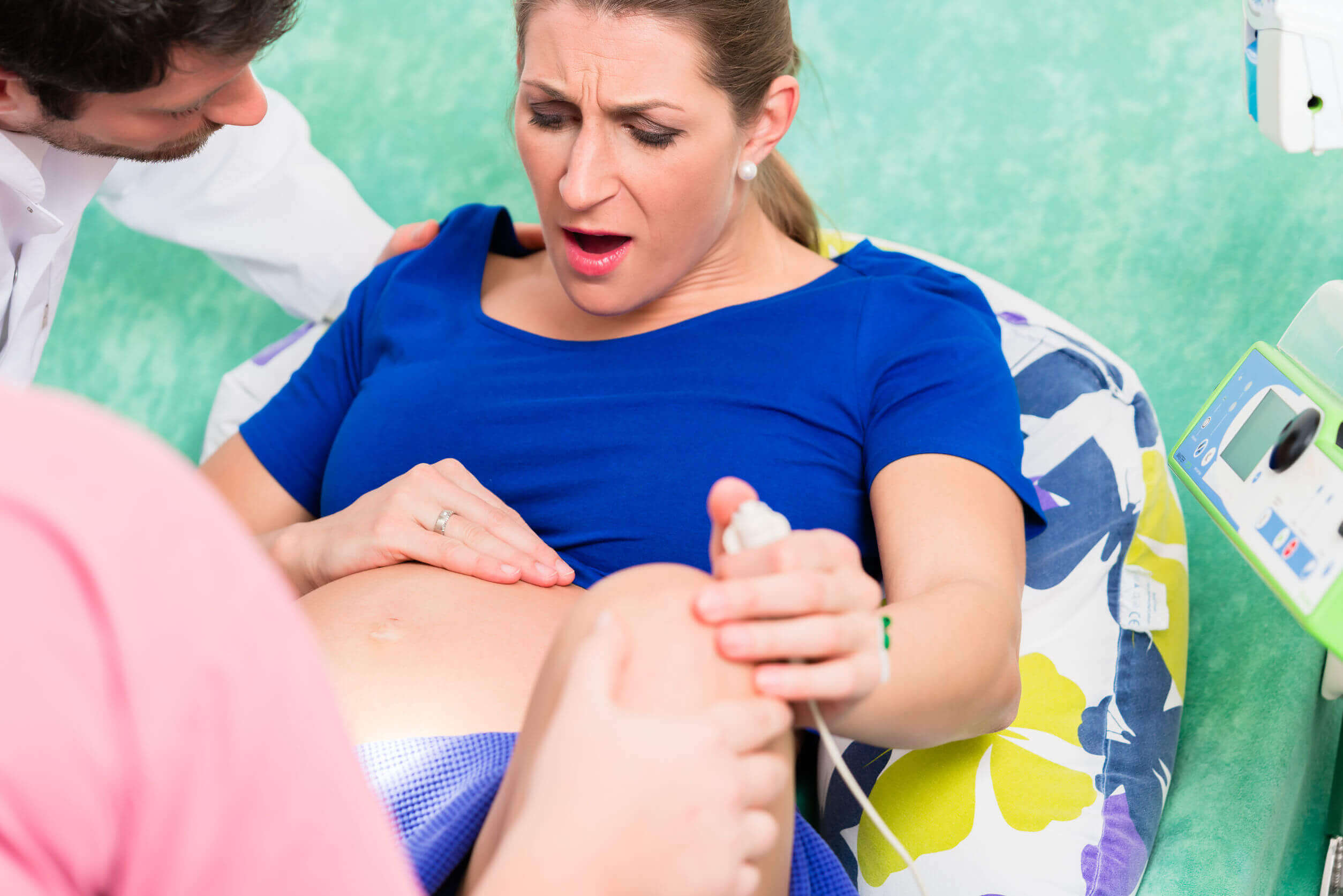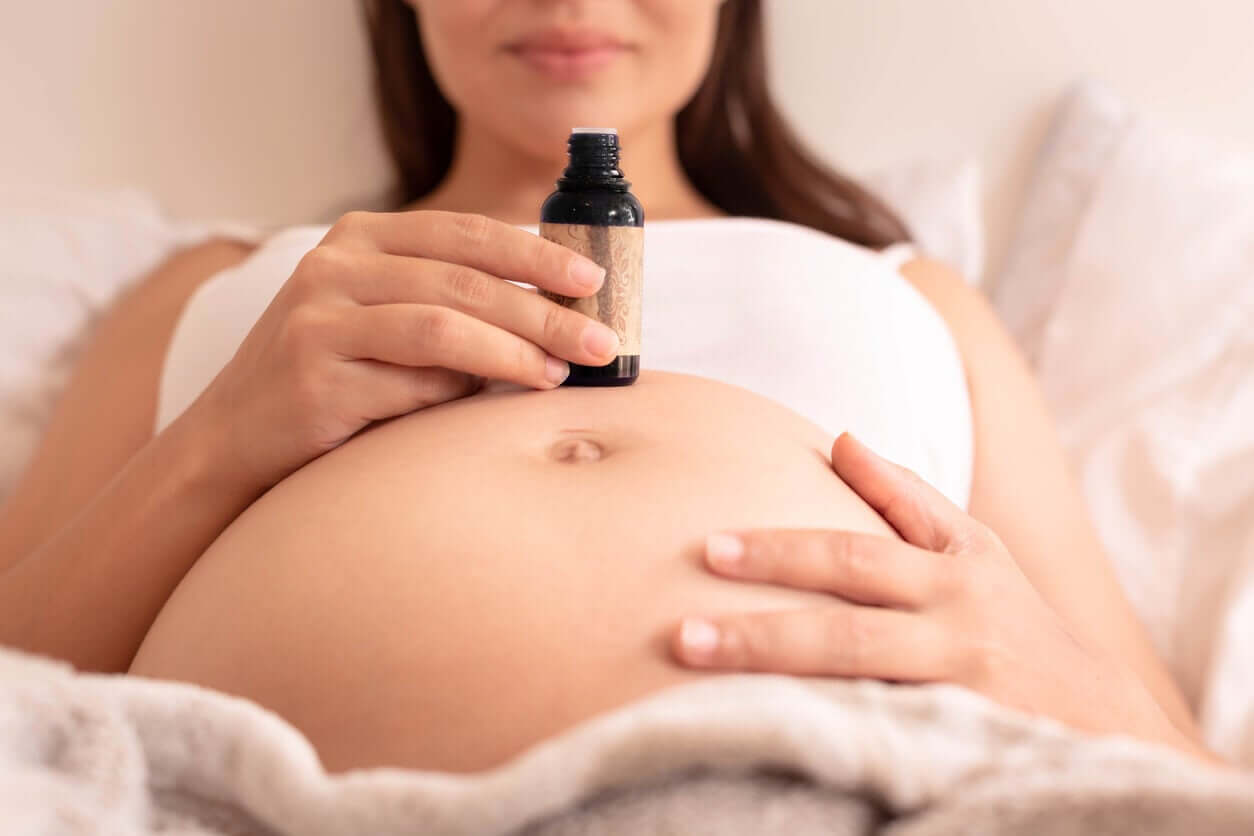How to Perform Perineal Massage to Prevent Tears in Childbirth?


Written and verified by the physiotherapist Maria Elisa Lisotti Luppi
During the process of dilation and expulsion of the baby, the pelvic floor muscles are stressed to their maximum capacity. This favors the appearance of tears, especially in first-time women. Perineal massage helps prevent such birth trauma and is extremely helpful during the final stages of pregnancy. Although episiotomy works to widen the vaginal cavity and prevent some unwanted outcomes, it also carries risks. For example, dysfunctions in the perineal area during postpartum. Therefore, today we’re going to show you what it consists of and how to perform perineal massage. Take note!
Perineal massage: What does it consist of?
Perineal massage is one of the most used techniques to prepare the pelvic floor muscles. At first, it may be a bit uncomfortable to manipulate this area, but the sensation will improve with successive repetitions. The key is to recognize and gently massage the muscles that surround the opening of the vagina.
On the one hand, perineal massage is focused on making the pelvic floor muscles more flexible to prevent perineal trauma during childbirth. On the other hand, it helps the woman to distend the natural canal and thus avoid the need for an episiotomy.

Benefits of perineal massage during pregnancy
Good conditioning for childbirth includes the physical and emotional preparation of the pregnant woman. This can be done through some exercises and adequate information.
The benefits of perineal massage are increasingly recognized and we’ll share them below:
- Increases local blood circulation: Like all massages, when you perform perineal massage, it improves muscle irrigation and thus increases the oxygenation of these structures.
- Improves the elasticity of the pelvic floor muscles.
- Perineal massage favors the body scheme of the pregnant woman: It helps the pregnant woman to understand some changes that occur during pregnancy and birth.
- Reduces the risk of pelvic trauma in childbirth: Due to decreased muscle endurance during maximal strain, these exercises limit the need for episiotomies.
How to perform perineal massage correctly?
From week 32 onward, you can begin to palpate the area and recognize your own body. It’s very useful to use a mirror to better understand your anatomy and its modifications.
From week 34, it’s important that you begin to massage the perineal area with a daily frequency or every other day. You can do it yourself or your partner can help you if you wish.
The process starts with a recognition of the area and then you begin to progressively massage by following the step-by-step instructions that we’ve prepared for you.
Self-massage
First of all, get into a comfortable position with your legs far enough apart and your back supported. This can be in your bed, in the bathtub, or sitting on the toilet. This is a great opportunity to recognize your pelvic floor and feel how those muscles are.
Sanitize your hands and cover them with a gliding medium to soften the massage. There are oils suitable for intimate areas or you can use any genital lubricant.
Once you’re ready, begin to feel the muscles surrounding the sphincters with your thumbs. That’s your pelvic floor. Then, insert your thumbs into the opening of the vagina, no more than 3 or 4 cm. Gently massage the edges in the direction of the pubis and then in the opposite direction.
You may feel discomfort and even some pain at first. But be patient and listen to your body! It’s not a caress, but a practice of muscular flexibility. Depending on how tense the area is and your basal sensitivity, different sensations will be obtained.
Allow your partner to help if you want
It depends on each woman if she prefers to do the massage alone or if it’s more comfortable for her to have her partner do it.
When the couple helps, it improves communication and understanding between them regarding the modifications in the pregnancy. In addition, it provides more tools to optimize the accompaniment of the pregnant woman.
Before starting, explain that it’s physical contact with a clear objective. It should be done slowly and progressively to be able to regulate the feeling of discomfort that you may perceive at the beginning. The technique is the same, only you’ll use the middle finger and the index finger (or the ring finger, depending on your comfort).
Once your partner learns the technique, you will likely be able to progressively relax during practice.
Some tips for when you perform perineal massage

If you’ve never practiced perineal massage, don’t give up at the first sign of discomfort. It’s important that you do it calmly and confidently, as it’s a benefit to go through the delivery with greater harmony.
We’ll offer you some tips to carry it out in an optimal way:
- Don’t rush or anticipate: The massage can be done from week 32 to 34 of gestation. In any case, consult your obstetrician before starting to apply it.
- Empty the intestine before doing it: Feeling like going to the bathroom during the massage is uncomfortable and makes it difficult to relax. Take the time to calmly go to the bathroom before you begin.
- Finish with a warm shower: This helps to deepen the relaxing effect of the massage.
- Keep a record: This is essential in order to achieve the desired effect, so try to do it for a few minutes every day.
This technique is a comprehensive preparation adapted for the birth of your baby, so we recommend you implement it. At the same time, consultation with a physiotherapist specialized in the pelvic floor can be of great help to evaluate the condition of your muscles and give you the tools to arrive at delivery in better conditions.
During the process of dilation and expulsion of the baby, the pelvic floor muscles are stressed to their maximum capacity. This favors the appearance of tears, especially in first-time women. Perineal massage helps prevent such birth trauma and is extremely helpful during the final stages of pregnancy. Although episiotomy works to widen the vaginal cavity and prevent some unwanted outcomes, it also carries risks. For example, dysfunctions in the perineal area during postpartum. Therefore, today we’re going to show you what it consists of and how to perform perineal massage. Take note!
Perineal massage: What does it consist of?
Perineal massage is one of the most used techniques to prepare the pelvic floor muscles. At first, it may be a bit uncomfortable to manipulate this area, but the sensation will improve with successive repetitions. The key is to recognize and gently massage the muscles that surround the opening of the vagina.
On the one hand, perineal massage is focused on making the pelvic floor muscles more flexible to prevent perineal trauma during childbirth. On the other hand, it helps the woman to distend the natural canal and thus avoid the need for an episiotomy.

Benefits of perineal massage during pregnancy
Good conditioning for childbirth includes the physical and emotional preparation of the pregnant woman. This can be done through some exercises and adequate information.
The benefits of perineal massage are increasingly recognized and we’ll share them below:
- Increases local blood circulation: Like all massages, when you perform perineal massage, it improves muscle irrigation and thus increases the oxygenation of these structures.
- Improves the elasticity of the pelvic floor muscles.
- Perineal massage favors the body scheme of the pregnant woman: It helps the pregnant woman to understand some changes that occur during pregnancy and birth.
- Reduces the risk of pelvic trauma in childbirth: Due to decreased muscle endurance during maximal strain, these exercises limit the need for episiotomies.
How to perform perineal massage correctly?
From week 32 onward, you can begin to palpate the area and recognize your own body. It’s very useful to use a mirror to better understand your anatomy and its modifications.
From week 34, it’s important that you begin to massage the perineal area with a daily frequency or every other day. You can do it yourself or your partner can help you if you wish.
The process starts with a recognition of the area and then you begin to progressively massage by following the step-by-step instructions that we’ve prepared for you.
Self-massage
First of all, get into a comfortable position with your legs far enough apart and your back supported. This can be in your bed, in the bathtub, or sitting on the toilet. This is a great opportunity to recognize your pelvic floor and feel how those muscles are.
Sanitize your hands and cover them with a gliding medium to soften the massage. There are oils suitable for intimate areas or you can use any genital lubricant.
Once you’re ready, begin to feel the muscles surrounding the sphincters with your thumbs. That’s your pelvic floor. Then, insert your thumbs into the opening of the vagina, no more than 3 or 4 cm. Gently massage the edges in the direction of the pubis and then in the opposite direction.
You may feel discomfort and even some pain at first. But be patient and listen to your body! It’s not a caress, but a practice of muscular flexibility. Depending on how tense the area is and your basal sensitivity, different sensations will be obtained.
Allow your partner to help if you want
It depends on each woman if she prefers to do the massage alone or if it’s more comfortable for her to have her partner do it.
When the couple helps, it improves communication and understanding between them regarding the modifications in the pregnancy. In addition, it provides more tools to optimize the accompaniment of the pregnant woman.
Before starting, explain that it’s physical contact with a clear objective. It should be done slowly and progressively to be able to regulate the feeling of discomfort that you may perceive at the beginning. The technique is the same, only you’ll use the middle finger and the index finger (or the ring finger, depending on your comfort).
Once your partner learns the technique, you will likely be able to progressively relax during practice.
Some tips for when you perform perineal massage

If you’ve never practiced perineal massage, don’t give up at the first sign of discomfort. It’s important that you do it calmly and confidently, as it’s a benefit to go through the delivery with greater harmony.
We’ll offer you some tips to carry it out in an optimal way:
- Don’t rush or anticipate: The massage can be done from week 32 to 34 of gestation. In any case, consult your obstetrician before starting to apply it.
- Empty the intestine before doing it: Feeling like going to the bathroom during the massage is uncomfortable and makes it difficult to relax. Take the time to calmly go to the bathroom before you begin.
- Finish with a warm shower: This helps to deepen the relaxing effect of the massage.
- Keep a record: This is essential in order to achieve the desired effect, so try to do it for a few minutes every day.
This technique is a comprehensive preparation adapted for the birth of your baby, so we recommend you implement it. At the same time, consultation with a physiotherapist specialized in the pelvic floor can be of great help to evaluate the condition of your muscles and give you the tools to arrive at delivery in better conditions.
All cited sources were thoroughly reviewed by our team to ensure their quality, reliability, currency, and validity. The bibliography of this article was considered reliable and of academic or scientific accuracy.
- Biana, Camilla Benigno, et al. “Terapias no farmacológicas aplicadas en el embarazo y el parto: una revisión integradora.” Revista da Escola de Enfermagem da USP 55 (2021).
- Coca, S. Gómez, Elena María Villamor Ruiz, and S. Ortiz Fernández. “Evidencia científica del masaje perineal y periné integro.” Trances: Transmisión del conocimiento educativo y de la salud 9.2 (2017): 131-142.
- Ferreira-Couto, Cristina Manuela, and Marinha do Nascimento Fernandes-Carneiro. “Prevención del trauma perineal: una revisión integradora de la literatura.” Enfermería Global 16.47 (2017): 539-575.
- Santamarina, E. Moral, et al. “Trauma perineal en el parto eutócico y su correlación con la estrategia de descenso progresivo de la tasa de episiotomía en nuestro medio.¿ Necesitamos reflexionar?.” (2021).
- Chicaiza, Jorge Victoriano Mejía, Cristian Andrés Gualán Cartuche, and Adrián Marcelo Mejía Calle. “PREVALENCIA DE EPISIOTOMÍA Y FACTORES ASOCIADOS, EN PACIENTES DEL CENTRO OBSTÉTRICO DEL HOSPITAL VICENTE CORRAL MOSCOSO, CUENCAECUADOR. 2014.” Revista de la Facultad de Ciencias Médicas de la Universidad de Cuenca35.1 (2017): 61-67.
This text is provided for informational purposes only and does not replace consultation with a professional. If in doubt, consult your specialist.








